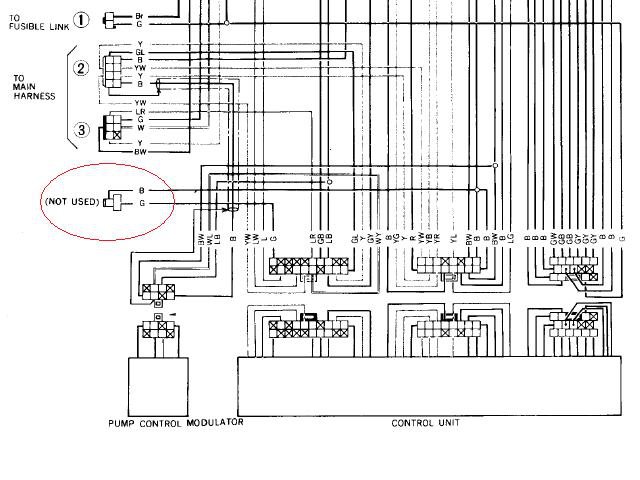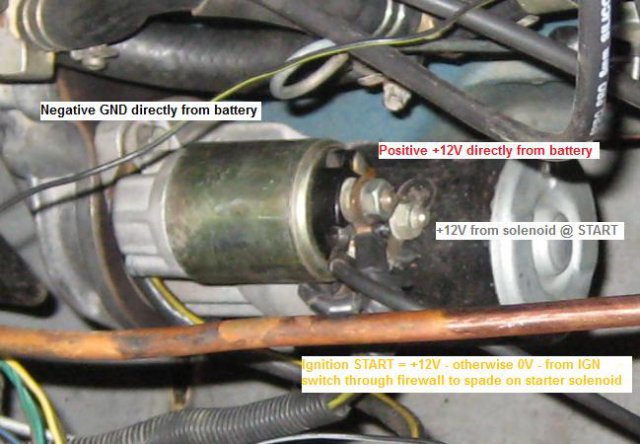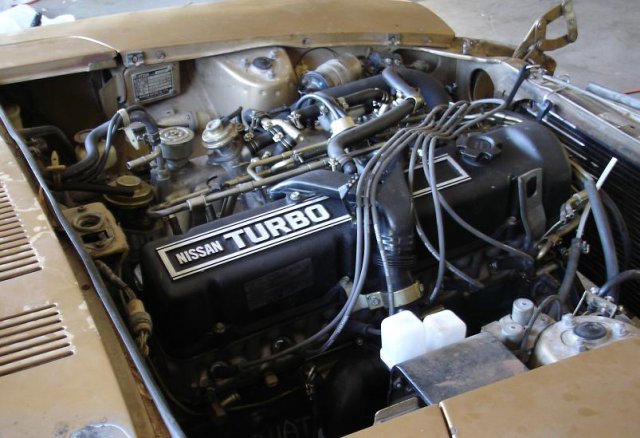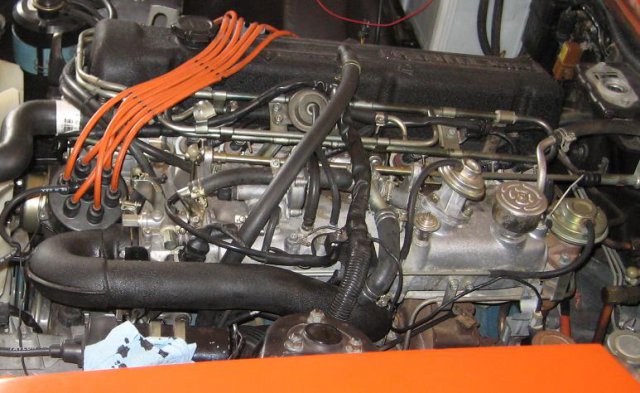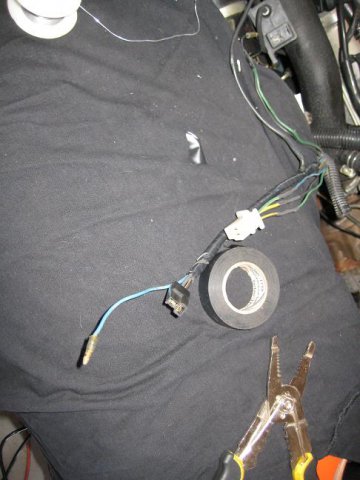-
Posts
673 -
Joined
-
Last visited
-
Days Won
8
Content Type
Profiles
Forums
Blogs
Events
Gallery
Downloads
Store
Everything posted by cgsheen
-
This is from the 280ZX Turbo wiring diagram. B = Black wire G = Green wire (NOT USED) = NOT USED!, No Connection!, Don't plug anything in here!, We're just hanging here to look pretty! Sockets 1, 2, and 3 are used to connect the L28ET ECCS (engine) harness to Power and to interface with the main harness(es) of the car. It's ALL right there in the turbo swap diagram.
-
-
But, straighten this out first: - You have a 1981 L28ET? (1981 280ZX Turbo engine) - Is has the EXTERNAL Crank Angle Sensor bolted to the front drivers side of the engine and wiring that goes up between the dizzy and t-stat housing (round 4-prong connector)? - Your ECCS (ECU-to-engine) harness is from a 1981 280ZXT and it has a dropping resistor pack? - Your ECU is from a 1981 280ZXT? - Are you sure the oil pump is stock 1981? (since the dizzy isn't there, post a picture of the "hole" it goes in - to make sure someone else hasn't already modded the engine to accept an '82-'83 distributor) If it's ALL stock 1981, then you need an '81 dizzy (which is essentially a body, cap and rotor - it doesn't do anything except distribute spark. Doesn't have any other electronics as the CAS is external and the ECU controls the Ignitor/Coil)
-

No power to starter/Ground issue?
cgsheen replied to Med Center Z's topic in Trouble Shooting / General Engine
-
You should replace the Receiver/Dryer (Accumulator - little bottle on the passenger side fender well). It's the main system "filter". Before you reinstalled the condenser and engine bay piping you probably should have run some A/C system cleaner through that stuff as a precaution. The early Z's don't use many o-rings. The tubing connections should be flare fittings and the o-rings in the system will be inside the compressor and inside the expansion valve - you don't want to mess with those as a general rule. It's helpful to reassemble flare connections by using a little A/C oil on each side of the flare itself. The oil you use should be the oil that's compatible with the type of refrigerant you'll be using. Sounds like you're converting to R134a? If so, you should have dumped as much of the mineral oil out of the compressor as you could, and replaced what came out with Ester Oil or PAG.
-

l28et swap running on three cylinders?
cgsheen replied to burn-t280zt's topic in Trouble Shooting / General Engine
Did you pull the plugs? -
Well... Your early 260Z didn't come with all that harness wire, sensors, and computer electronics you just installed. And, you've probably added some other electrical / electronic devices as well. Don't tell me you kept the stock AM radio with a single speaker in the back. Still using sealed beam headlights? As I said, many of us use the 280ZXT alternator because it can pump out nearly twice the amperage as the original 260Z alternator. But, that's a change you can make - or not - anytime you want...
-
If you're installing the stock alternator onto your turbo engine, don't touch a thing. Most of us use the alternator that comes with the L28ET - it puts out more amps - BUT it has an internal voltage regulator AND needs to be re-wired a little when used in an early Z frame. When I did my swap, I used the L28ET alternator, removed my external voltage reg., removed the shunt and ammeter, installed a '77 voltage gauge in place of the ammeter, and re-wired that whole "section" of my stock harness.
-
He means: "Sort of"... The early 260 has an electric fuel pump, but you can't use it with the turbo motor. You need a fuel pump made for fuel injection or the 280ZX Turbo fuel pump. And, you're going to be wiring it differently than the stock wiring... The 260 fuel pump gets it's power thru a couple of "safety" relays. You won't be using those. The fuel pump "safety" IS the ECU, so you need to re-wire your fuel pump JUST like in the diagram. The rest of it is fairly straight forward, but your 260 won't have all the fusable links you need, get another set or use the fusable link box from a 280ZX. No changes IF you use the 260 alternator. If you use the 280ZX Turbo alternator, you'll be re-doing you alternator wiring and eliminating your external voltage regulator. I'm sure I'm forgetting something, but as you're doing all this, take the time to check and clean EVERY electrical connection - then clean and "De-Ox-It" again... Make sure your vacuum connections are good, you can"t have leaks - no open ports. DON'T screw with the AFM!
-
The Black/white wire should have +12V at IGN ON - it supplies power to both the Ignitor and Coil. The Yellow is the "trigger" signal from the ECU and shouldn't be showing battery voltage ever, IIRC... The ECU controls the firing of the coil. The "Ignitor" is a transistor (ignition unit) that amplifies the signal from the ECU to a value that will cause the coil to fire. Re-check that particular wiring to the ECU. If you haven't read this by now: Most common problem with these old EFI and ECCS systems is wiring, connections, and connectors! They corrode over the years. Check and clean them all - then do it again... Oh... The Ignitor is a transistorized "solid state" component (not a relay or anything) - I've never known one to "click". You don't have any cracks in the coil do you? You CAN'T use an N/A distributor on a turbo engine. They are two DIFFERENT animals. On the Turbo engine, the distributor holds the Crank Angle Sensor (optical wheel built in). The ECU uses the CAS signal to know when to fire the injectors and when to fire the coil. The 4 wires from the turbo dizzy need to be properly connected to the ECU. ALL the methods of testing the wiring and components are spelled out in the FSM. Pretty easy to do if you follow the testing and troubleshooting guide in the FSM.
-
Ya, the stock L28ET does reach it's HP max at around 5300RPM or so. But it's still accelerating past that point. I have a '77 5-speed attached to my L28ET, but I'm using the stock 260 R180 (3.364). I've never really lost boost between 2nd and 3rd and I'm normally shifting somewhere around 4800-5500 when running in full boost... I have to say, swapping to a MAF made a large difference in my boost response though.
-

Noob to turbo swap into a 240z ignitor harness separate?
cgsheen replied to motomanmike's topic in Nissan L6 Forum
I think I misunderstood. If it's the Ignitor that you're missing, and you can't find a turbo coil/ignitor, just use the GM HEI module to fire your coil. Simple to wire in the stock harness and a good, inexpensive replacement for the stock ignitor. -
Like "kid", you need to get the FSM for your model year and run through the troubleshooting steps in the EFI section. When you read the FSM you'll note that the electric fuel pump is wired to come on with the "start signal" (when the starter is engaged), then it's operation is supposed to be controlled by some safety mechanism that proves the engine is running (switch inside the AFM showing flapper movement, oil pressure switch, sensing the alternator spinning - Nissan used various methods (until they figured out the best way was to use the ECU to control the fuel pump - but none of the early Z's used that method)). None of the early Z's used a "fuel prime" - the fuel pump should not start at IGN ON (not until START, and after that should only continue to run if the "safties" have proved the engine is running). Sounds like something is wrong (or has been changed) with your wiring. Get the FSM, do the tests, understand how your year operates...
-
??? He can discern fuel pressure by looking at a metal pipe? (this guy I have to meet...) And he thinks too much fuel pressure makes an engine run lean?? Black plugs don't = lean as a general rule. You need to get the FSM and follow ALL the EFI trouble shooting steps in the Manual. Pretty simple tests. You also need to stop assuming you need to replace this-or-that part. Do the tests, find out for certain which parts are good & which aren't. 90% of the time newb's think they have a bad AFM when they don't. 90% of the time it's electrical connectors / connections. Get the FSM, do the tests. Don't fool with the AFM until you've tested everything else at least twice.
-

Noob to turbo swap into a 240z ignitor harness separate?
cgsheen replied to motomanmike's topic in Nissan L6 Forum
And, it's VERY simple... If you don't have the coil/ignitor harness - or have trouble finding one, just build your own. It's only a couple of wires to the ignitor (power and the "trigger" signal from the ECU) and some simple wiring to the coil. (Having said that, if I'd known then what I know now, I'd NEVER have used the stock engine management when I did my turbo swap. Using the ECU, MAF, Coil, & TPS off a VG30e engine is a much better way to go... With a bone stock "A18" ECU & MAF, my L28ET runs much better than the original ECU and AFM - especially under boost.) -
In an '80 280ZX, the fuel pump isn't connected to the ECU. It's powered through 2 or 3 relays (depending on manuf date or which FSM you look at) that only depend on: the start signal, the oil pressure switch, and/or the alternator signal.
-
Did you calibrate (re-calibrate) the wideband sensor?
-
Here's the only thing I was refering to (which is the only thing you can really tell from your pics) - Pics of bone-stock L28ET Intake Manifold, J-pipe. Yours is obviously altered - not saying that's necessarily bad - just that you may need to understand the differences...
-
That engine is NOT a stock L28ET. So, ya, it kind of looks like a "frankenstein"... You may have to see what the stock engine really looks like to understand the differences.
-
The FSM has very good trouble shooting steps and all the tests on the ECCS are fairly simple if you have a multimeter in hand. Most of the problems on the L28ET come from poor, corroded, and/or missing electrical connectors/connections and/or vacuum hoses/connections, cracked intake boots. Check and clean them all, replace if necessary. Specifically at startup, a malfunctioning Air Bypass Valve on the intake manifold, and/or a malfunctioning A.A.C. valve will cause a rich condition. The Air Bypass is electrical, the A.A.C. is vacuum (controlled the the VCM (Vacuum Comtrol Module) - which is a couple of vacuum solenoids that the ECU uses to control the A.A.C. and EGR valves). You can check that, but I'd recommend you going through the entire ECCS system and follow all the trouble shooting steps in the FSM. Many people jump at the AFM, thinking they can make adjustments, when it's the LAST thing they should do. If all the other parts in the ECCS system are working properly, connected properly, there's no reason to bust open the AFM.
-
http://www.300zx.cl/ga/300zx/images/serial%20number%20Datsun%20Z%20Car.htm Look there... That VIN is in the proper range for the '73 model year...
-
That's exactly what I did! Paperclip flattened to make a custom pin release... I'm using an Infiniti M30 ECU - isn't it amazing what a little better engine management can do!
-
Oil the heck out of it to get it rotating freely. With the door open you can turn it to the "latched position" and release it with the door handle - repeatedly! while oiling - until it's turning uber-smoothly and easily. Replace the missing "black rubber part" with a short piece of 3/8" plastic tubing. Make it as wide as your original and then cut it down the side, open it up a bit, and install it on the egg-shaped lobe on the latch...
-

whay does a 280zx turbo ignition harness look like?
cgsheen replied to Milenko2121's topic in Ignition and Electrical
Here's one end of it. The Ignition harness in a 280ZX Turbo runs along the driver fender well from the Coil/Ignitor assembly to the cockpit under the drivers feet. It's probably 4 or 5 feet long - it's been 3 years since I pulled mine out of the donor car. It delivers +12V to the Ignitor and coil plus a signal from the ECU to fire the coil & a Tach signal back to the instrument cluster. IIRC, bundled in there is also the power and signal wires for the boost sensor and the signal wire to the A/C compressor clutch. The FSM tells all about the wiring needed so if you can't find a whole one, you can make your own fairly easily... (In the picture, only the blue wire and the 2-wire black "T" socket are for the coil/ignitor... The white socket goes to the boost sensor. There's probably a GND wire in there somewhere and the wire for the A/C compressor) -

Early 260z L28et swap wiring issues
cgsheen replied to TheBlaiant's topic in S30 Series - 240z, 260z, 280z
You need to get the Factory Service Manuals for your two cars - the S30 that's your frame and the S130 the engine came out of. It'll probably be helpful to find someone with an intact engine harness to show you what yours should actually look like and what everything does. If you're good at following electrical diagrams you'll figure all that out... A little clarification on something posted above: The two single wires to the thermostat housing = yellow wire to temperature sender (Thermal Transmitter - not actually part of the ECCS system, just runs the coolant temperature gauge in the cockpit) On the L28ET it's the sensor without a little wire coming out of it. The sensor with the little wire is a temperature switch (Thermotime Switch or Water Temperature Switch) - the white wire goes to this sensor. You'll probably never use this one. It's not part of the ECCS system either. On the 280ZX, this switch will run the Injector Blower to cool off the injectors and fuel rail if the coolant temp is very hot when the engine is shut off. You'd need to have the blower and it's controller box installed and wired properly for that function to work. Mine has never been operational.

